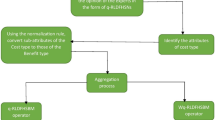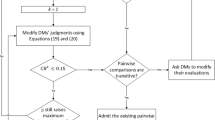Abstract
This article deals with a classical economic order quantity (EOQ) model under monsoon type fuzzy demand rate. It is nothing but the generalization of cloudy fuzzy model. We split the EOQ model into three parts according to the real-time fuzzy components of the demand rate. To defuzzify the model we develop an algorithm and the solution is obtained with the help of a nonlinear optimization technique that requires maximum aspiration level of the fuzzy membership of the objective function. Moreover, for comparative study we take numerical results of the crisp, general fuzzy and cloudy fuzzy model also. By this study we have shown that the decision maker might have to choose the monsoon type fuzzy environment all the time to control the proposed inventory. Moreover, sensitivity analysis and graphical illustrations are made to justify the new fuzzy approach.










Similar content being viewed by others
References
Harris F 1915 Operations and cost. In: Factory Management Series. Chicago: A. W. Shaw Company
Mahata G C and Mahata P 2011 Analysis of a fuzzy economic order quantity model for deteriorating items under retailer partial trade credit financing in a supply chain. Mathematical and Computer Modelling 53: 1621–1636
Yao J S and Su J S 2000 Fuzzy inventory with backorder for fuzzy total demand based on interval-valued fuzzy set. European Journal of Operational Research 124: 390–408
Wu K and Yao J S 2003 Fuzzy inventory with backorder for fuzzy order quantity and fuzzy shortage quantity. European Journal of Operational Research 150: 320–352
Björk K M 2009 An analytical solution to a fuzzy economic order quantity problem. International Journal of Approximate Reasoning 50: 485–493
Chang H C 2004 An application of fuzzy sets theory to the EOQ model with imperfect quality items. Computers & Operations Research 31: 2079–2092
Mahata G C and Goswami A 2007 An EOQ model for deteriorating items under trade credit financing in the fuzzy sense. Production Planning and Control 18: 681–692
Sharifi E, Shabani S, Sobhanallahi M A and Mirzazadeh A 2015 A fuzzy economic order quantity model for items with imperfect quality and partial backordered shortage under screening errors. International Journal of Applied Decision Sciences 8: 109–126
De S K, Kundu P K and Goswami A 2003 An Economic Production Quantity inventory model involving fuzzy demand rate and fuzzy deterioration rate. Journal of Applied Mathematics and Computing 12(1): 251–260
De S K, Kundu P K and Goswami A 2008 Economic ordering policy of deteriorated items with shortage and fuzzy cost co-efficients for vendor and buyer. International Journal of Fuzzy Systems and Rough Systems 1(2): 69–76
Mahata G C and Goswami A 2013 Fuzzy inventory models for items with imperfect quality and shortage backordering under crisp and fuzzy decision variables. Computers & Industrial Engineering 64: 190–199
Bellman R E and Zadeh L A 1970 Decision making in a fuzzy environment. Management Science 17: B141–B164
Park K 1987 Fuzzy-set theoretic interpretation of economic order quantity. IEEE Transactions on Systems, Man and Cybernetics 17: 1082–1084
Guiffrida A L 2009 Fuzzy inventory models. In: Inventory Management: Non-Classical Views, p. 173
Shekarian E, Glock C H, Amiri S M P and Schwindl K 2014 Optimal manufacturing lot size for a single-stage production system with rework in a fuzzy environment. Journal of Intelligent and Fuzzy Systems 27(6): 3067–3080
Shekarian E, Olugu E U, Abdul-Rashid S H and Kazemi N 2016 An economic order quantity model considering different holding costs for imperfect quality items subject to fuzziness and learning. Journal of Intelligent and Fuzzy Systems 30(5): 2985–2997
Chen S H and Chang S M 2008 Optimization of fuzzy production inventory model with unrepairable defective products. International Journal of Production Economics 113: 887–894
Shekarian E, Olugu E U, Abdul-Rashid S H and Bottani E 2016 A fuzzy reverse logistics inventory system integrating economic order/production quantity models. International Journal of Fuzzy Systems, https://doi.org/10.1007/s40815-015-0129-x
Pal S, Mahapatra G and Samanta G 2014 An EPQ model of ramp type demand with Weibull deterioration under inflation and finite horizon in crisp and fuzzy environment. International Journal of Production Economics 156: 159–166
Báez-Sáncheza A D, Morettib A C and Rojas-Medarc M A 2012 On polygonal fuzzy sets and numbers. Fuzzy Sets and Systems 209: 54–65
Wang X and Tang W 2009 Optimal production run length in deteriorating production processes with fuzzy elapsed time. Computers and Industrial Engineering 56(4): 1627–1632
Zhang C, Zhao R and Tang W 2009 Optimal run lengths in deteriorating production processes in random fuzzy environments. Computers and Industrial Engineering 57(3): 941–948
Hu J S, Zheng H, Guo C Y and Ji Y P 2010 Optimal production run length with imperfect production processes and backorder in fuzzy random environment Computers and Industrial Engineering 59(1): 9–15
Chakraborty N, Mondal S and Maiti M 2013 A deteriorating multi-item inventory model with price discount and variable demands via fuzzy logic under resource constraints. Computers & Industrial Engineering 66(4): 976–987
De S K 2013 EOQ model with natural idle time and wrongly measured demand rate. International Journal of Inventory Control and Management 3(1–2): 329–354
De S K and Sana S S 2013 Fuzzy order quantity inventory model with fuzzy shortage quantity and fuzzy promotional index. Economic Modelling 31: 351–358
Kumar R S, De S K and Goswami A 2012 Fuzzy EOQ models with ramp type demand rate, partial backlogging and time dependent deterioration rate. International Journal of Mathematics in Operational Research 4: 473–502
De S K and Sana S S 2015 An EOQ model with backlogging. International Journal of Management Sciences and Engineering Management, https://doi.org/10.1080/17509653.2014.995736
Das B C, Das B and Mondal S K 2015 An integrated production inventory model under interactive fuzzy credit period for deteriorating item with several markets. Applied Soft Computing 28: 453–465
Kumar R S and Goswami A 2015 A fuzzy random EPQ model for imperfect quality items with possibility and necessity constraints. Applied Soft Computing 34: 838–850
Mahata G C 2017 A production-inventory model with imperfect production process and partial backlogging under learning considerations in fuzzy random environments. Journal of Intelligent Manufacturing 28: 883–897
Shekarian E, Kazemi N, Hanim Abdul-Rashid S H and Olugu E U 2017 Fuzzy inventory models: a comprehensive review. Applied Soft Computing 55: 588–621
De S K and Beg I 2016 Triangular dense fuzzy sets and new defuzzification methods. Journal of Intelligent and Fuzzy Systems 31(1): 467–476
De S K and Beg I 2016 Triangular dense fuzzy neutrosophic sets. Neutrosophic Sets and Systems 13: 24–37
De S K and Mahata G C 2017 Decision of a fuzzy inventory with fuzzy backorder model under cloudy fuzzy demand rate. International Journal of Applied and Computational Mathematics 3(3): 2593–2609
De S K 2017 Triangular dense fuzzy lock set. Soft Computing, https://doi.org/10.1007/s00500-017-2726-0
Karmakar S, De S K and Goswami A 2017 A pollution sensitive dense fuzzy economic production quantity model with cycle time dependent production rate. Journal of Cleaner Production 154: 139–150
Karmakar S, De S K and Goswami A 2018 A pollution sensitive remanufacturing model with waste items: triangular dense fuzzy lock set approach. Journal of Cleaner Production, https://doi.org/10.1016/j.jclepro.2018.03.161
Maity S, De S K and Pal M 2018 Two decision makers’ single decision over a back order EOQ model with dense fuzzy demand rate. Finance and Market 3: 1–11
Chu T and Tsao C 2002 Ranking fuzzy numbers with an area between the centroid point and original point. Computational Mathematics and Applications 43: 111–117
Ramli N and Mohamad D 2009 A comparative analysis of centroid methods in ranking fuzzy numbers. European Journal of Scientific Research 28(3): 492–501
Allahviranloo T and Saneifard R 2012 Defuzzification method for ranking fuzzy numbers based on center of gravity. Iranian Journal of Fuzzy Systems 9(6): 57–67
Ezzati R, Allahviranloo T, Khezerloo S and Khezerloo M 2012 An approach for ranking of fuzzy numbers. Expert Systems with Applications 39: 690–695
Deng H 2014 Comparing and ranking fuzzy numbers using ideal solutions. Applied Mathematical Modelling 38: 1638–1646
Cheng C H 1998 A new approach for ranking fuzzy numbers by distance method. Fuzzy Sets and Systems 95: 307–317
Buckley J J and Chanas S 1989 A fast method of ranking alternatives using fuzzy numbers. Fuzzy Sets and Systems 30: 337–339
Ezatti R and Saneifard R 2010 A new approach for ranking of fuzzy numbers with continuous weighted quasi-arithmetic means. Mathematical Sciences 4: 143–158
Wang Z X, Liu Y J, Fan Z P and Feng B 2009 Ranking L–R fuzzy number based on deviation degree. Information Sciences 179: 2070–2077
Kumar A, Singh P, Kaur P and Kaur A 2011 A new approach for ranking of L–R type generalized fuzzy numbers. Expert Systems with Applications 38: 10906–10910
Hajjari T and Abbasbandy S 2011 A note on ‘‘The revised method of ranking LR fuzzy number based on deviation degree”. Expert Systems with Applications 39: 13491–13492
Kumar R S 2018 Modelling a type-2 fuzzy inventory system considering items with imperfect quality ad shortage backlogging. Sadhana 43: 163–175
Yager R 1981 A procedure for ordering fuzzy subsets of the unit interval. Information Sciences 24(2): 143–161
Acknowledgements
The authors express sincere thanks to the editor and the anonymous reviewers for their valuable and constructive comments and suggestions, which led to a significant improvement of an earlier version of the manuscript.
Author information
Authors and Affiliations
Corresponding author
Appendix A
Appendix A
1.1 A practical example of the proposed model
Suppose a salesman (DM) purchases (orders) goods after six days in a week. The amount of stock is decided according to weekly demand rate by the seller. Learning and gaining demand status of the first week(s) are used to order the items accordingly for the second week. Similarly, gaining the experience from the second week(s), he may change the amounts of order quantity accordingly for the next week and so on.
On the other hand, if the salesman wants to apply his/her learning experiences day-wise for the selling process, the he/she may shorten the length of cycle time accordingly. In this case the demand rate might vary in any two or three consecutive days, and hence the order quantity also. Thus the problem is as follows:
-
(i)
Is it profitable if the DM replenishes his/her order quantities once after each and every cycle time, where the length of each cycle time does not vary in a non-random uncertain system?
-
(ii)
Is it profitable if the DM replenishes his/her order quantities once after each and every cycle time, where the length of each cycle time varies from one cycle to another in a non-random uncertain system?
The answer is too much popular, because the basic aim of inventory management is to minimize system cost (or maximizing profit); hence, obviously the second case will give the minimum system cost and hence it is a part of monsoon type fuzzy model.
Since the basic aim of learning is to minimize inventory cost, obviously for the second case the average inventory cost will be minimum.
Rights and permissions
About this article
Cite this article
DE, S.K., MAHATA, G.C. A comprehensive study of an economic order quantity model under fuzzy monsoon demand. Sādhanā 44, 89 (2019). https://doi.org/10.1007/s12046-019-1059-3
Received:
Revised:
Accepted:
Published:
DOI: https://doi.org/10.1007/s12046-019-1059-3




